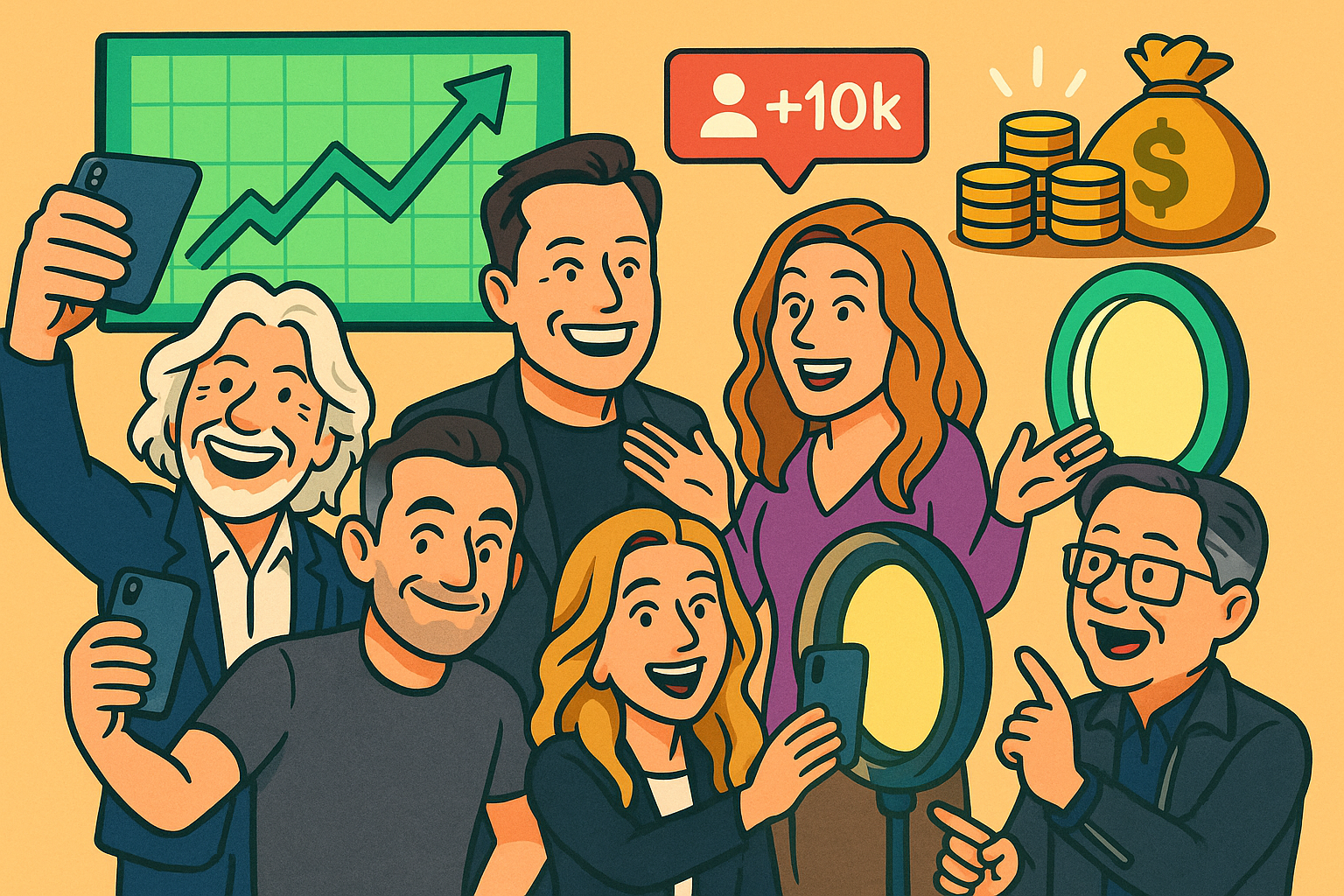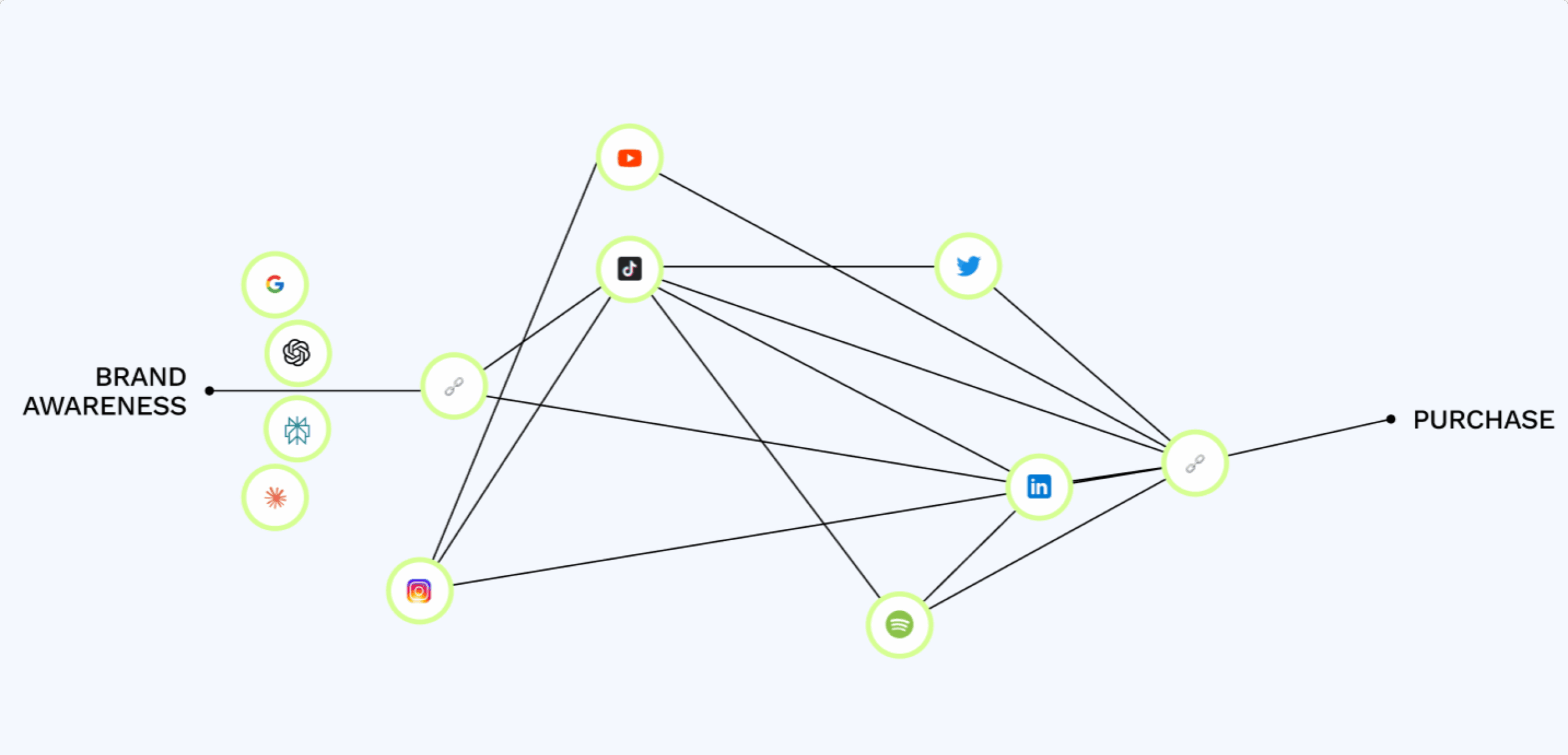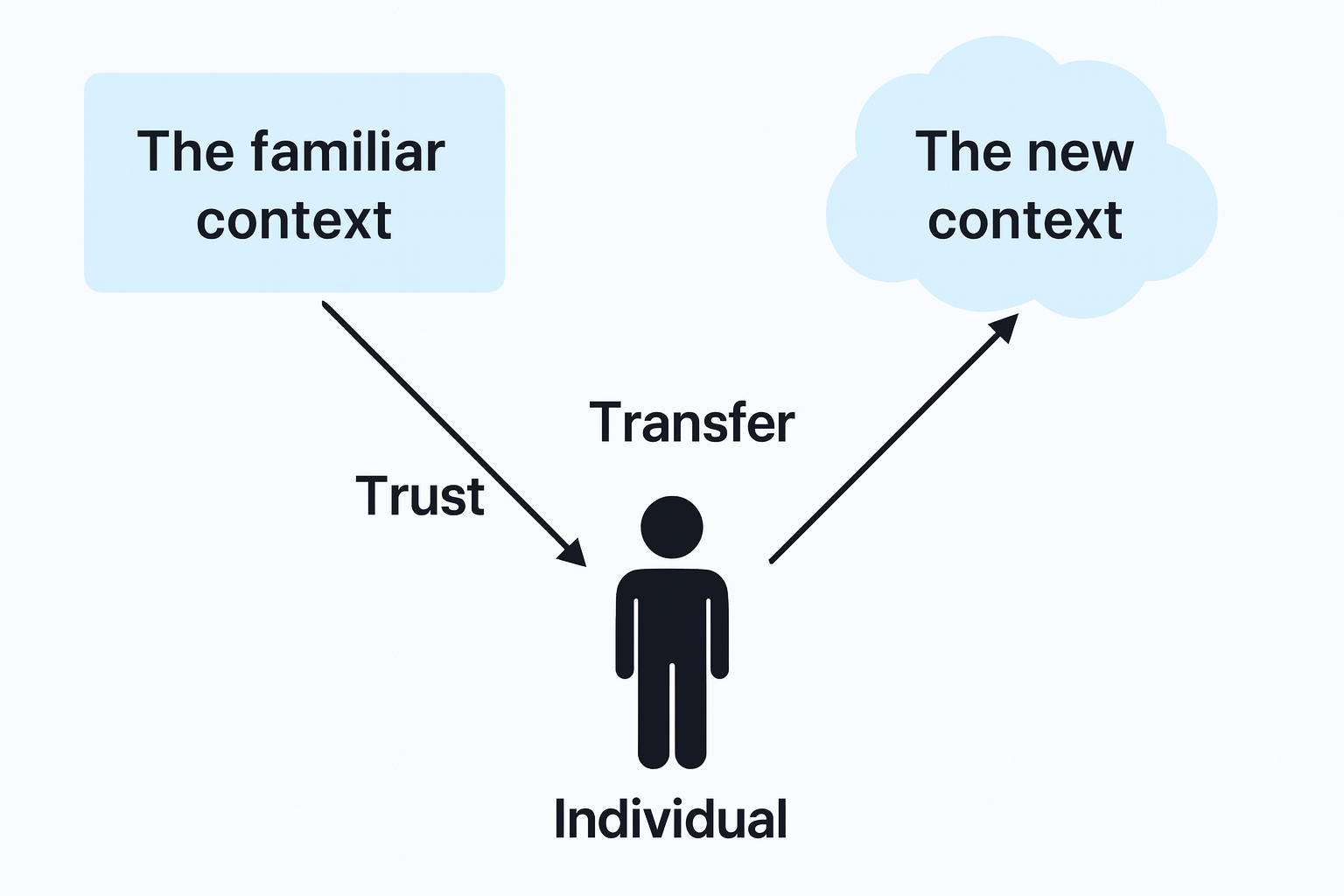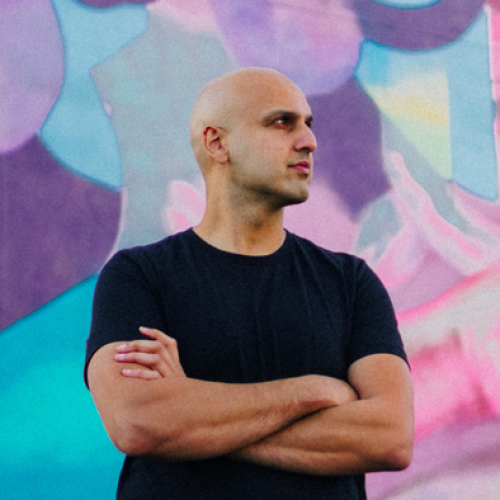Imagine you’re scrolling through LinkedIn at 7 AM with your coffee, and you see a post from Jensen Huang talking about the future of AI chips. Then you spot Sara Blakely sharing a behind-the-scenes look at her latest Spanx board meeting. Next, there’s Marc Benioff from Salesforce weighing in on the future of work.
These aren’t random social media posts. They’re strategic moves in the creator economy—and if you’re not playing the ceo personal brand game, you’re already losing.
I’ve been watching this shift happen for years now, and I can tell you with certainty: we’re at an inflection point. In the next 12-24 months, AI is going to fundamentally change how customers discover and choose businesses. And here’s the part that should keep you up at night. AI doesn’t just consume data about your products or services. It consumes data about you.
When someone asks ChatGPT or Perplexity about your company, or even just about your industry, the AI won’t just explain your products. It will connect your company to you, pulling in your name, your past interviews, and your public content as part of its answer. If there’s nothing compelling for it to find, your competitor’s CEO will get that spotlight instead. And in an AI-first world, that means you’re invisible before the conversation even starts.
Key Takeaways
- AI Is Changing Customer Discovery – AI tools will increasingly connect companies with their CEOs in search results, pulling from public content, interviews, and media mentions to shape buying decisions.
- CEO Visibility Drives Business Wins – Deals are now being won or lost before sales teams even engage, based on how visible and compelling the leadership team appears online.
- Authority Comes From Strategic Content – The most successful CEOs use a consistent “show format” to position themselves at the intersection of their expertise, their industry, and market conversations.
- A Strong Personal Brand Compounds Trust – When customers trust a CEO personally, that trust transfers to the company, shortening sales cycles, improving close rates, and creating a durable competitive advantage.
The New Customer Journey in Age of AI
Your customers aren’t finding you the way they used to. They’re not Googling “best enterprise software” anymore. They’re asking AI for recommendations. They’re watching TikToks from founders who explain complex concepts in 60 seconds. They’re watching 10-minute YouTube videos from CEOs who share strategic insights. They’re following CEOs on LinkedIn who make them think differently about their industry.
I was in the car with my friend and client Neil Patel while he was on the phone with a nine-figure entrepreneur. Neil was telling him about his ad agency NPDigital that works with global billion-dollar brands, and how AI is changing the way deals get made. He explained that when CMOs are putting together RFPs now, they’re asking AI who the top players are, and then sending RFPs to those names. They’re literally just going with whoever the AI recommends.
Think about that for a second. Deals are being won and lost before sales teams even know there’s an opportunity.
And because Neil has such a strong digital presence through his blog and social channels, his $100M ad agency can compete with, and often beat, multi-billion-dollar agencies. His personal brand is the differentiator that gets him into those conversations.
According to studies on CEO reputation and company valuation, up to 44% of a company’s market value can be attributed to CEO reputation, and companies with highly visible CEOs outperform the stock market by up to 15% annually.
This isn’t some distant future scenario. Research shows that 82% of consumers are more likely to trust a company with visible senior leaders, and that number jumps to 77% for actual purchasing decisions when the CEO is active on social media.
But here’s what most executives miss: visibility isn’t enough anymore. You need to be the person people think of when they think about your space. This is referred to as “Topical Authority”—and you need it now.
Why Traditional CEO Branding Advice Is Dead Wrong
Most personal branding advice for CEOs is surface-level fluff. It’s all about “sharing your values” and “being authentic.” That’s table stakes now. Everyone’s authentic. Everyone has values.
What separates the CEOs who become industry icons from those who stay invisible isn’t their authenticity—it’s their ability to consistently insert themselves into the conversations that matter most to their business.
Take Brian Chesky from Airbnb. He doesn’t just post about “company culture” or “leadership lessons.” Watch his content, and you’ll notice something different: he’s always positioning himself at the intersection of travel, technology, and the future of living. Every post, every interview, every tweet reinforces his authority on these topics. So when journalists need a quote about the sharing economy, when investors are thinking about travel tech, when customers are considering short-term rentals—Brian is the name that comes to mind.
That’s not accident. That’s strategy.
The Social-First Format That Actually Works (And Why Most CEOs Get This Wrong)
Here’s where I see most executives completely miss the mark. They think personal branding means posting random thoughts on LinkedIn or sharing company updates. That’s not a brand—that’s noise.
What you need is what I call a “Social-First Format”—a consistent way of showing up that makes you instantly recognizable and habitually valuable to your audience.
Let me show you what I mean with some examples I’ve been tracking:
Gary Vaynerchuk (VaynerMedia)
Gary is the archetype of the CEO-as-creator playbook. Multiple daily posts, high-production show formats, constant Q&A clips—he’s turned his entire business leadership style into content. Watch his approach: he merges business insights with personal stories in a way that drives both dealflow and cultural presence. He’s not just running an agency; he’s creating the blueprint for how modern CEOs should show up.
View this profile on Instagram
Codie Sanchez (Contrarian Thinking)
Codie has turned her founder brand into a multi-platform content engine that most traditional CEOs should study. Daily shorts about buying small businesses, behind-the-scenes podcasts, newsletters breaking down deal structures—she’s created a show format that educates while building massive authority in the acquisition space. Her content feels like getting an MBA in real-time.
View this profile on Instagram
Ben Francis (Gymshark)
Ben runs what feels like a reality series about building a global fitness brand. Constant behind-the-scenes YouTube videos showing business decisions, Instagram Stories from board meetings, real-time documentation of product launches—he’s made the entire journey of scaling Gymshark into appointment viewing for entrepreneurs and fitness enthusiasts alike.
View this profile on Instagram
Notice the pattern? They’re not just sharing random thoughts. They’ve each created a consistent show format that builds authority in their specific domain while making them incredibly watchable.
The Mass Appeal Rule
Now, you might be thinking: “But my audience is pretty niche. Shouldn’t I focus on them?”
This is where most CEOs get trapped. They think they need to only speak to their exact customer. But here’s what I learned from working with and studying the most successful CEO brands: you need to think like a media company, not like a sales team.
Look at how Kolin Jones from Amalfi Jets does this. His business is private jet chartering—literally 0.01% of people watching his content will ever book a flight. But his TikToks get millions of views because he makes private aviation accessible and entertaining to everyone. He does comedy skits about client calls, explains how different jets work, and gives behind-the-scenes looks at luxury travel.
@thekolinjones
The result? His actual customers (ultra-wealthy individuals) end up seeing his content because the algorithm rewards engagement. But more importantly, when someone in his target demographic needs a private jet, guess who comes to mind?
You need to expand your aperture. Your content should work for:
- Your direct customers
- Industry peers and partners
- Potential employees
- Journalists and analysts
- Investors and board members
- People who influence your customers’ decisions
When you create content that multiple audiences find valuable, you multiply your reach and increase the chances that it circles back to the people who actually buy from you.
Your Expertise Intersection: Where Authority Gets Built
Instead of trying to be everything to everyone, you need to find your unique intersection. This is where your background, your company’s position, and market conversations converge.
Leila Hormozi (Acquisition.com)
Leila owns the intersection of business acquisitions and systematic operations. Every piece of content, whether she’s breaking down deal structures or sharing frameworks for scaling companies—reinforces her authority on both acquiring businesses and building bulletproof systems to run them.
View this profile on Instagram
Daymond John (FUBU/Shark Tank)
Daymond consistently positions himself at the intersection of fashion entrepreneurship and business mentorship. His content doesn’t just promote his brands—it educates aspiring entrepreneurs on building from nothing, personal branding, and turning passion into profitable businesses.
View this profile on Instagram
Sophia Amoruso (Nasty Gal/Girlboss)
Sophia has positioned herself at the intersection of e-commerce and female entrepreneurship. Whether she’s sharing business-building strategies or discussing women’s empowerment in business, every piece of content reinforces her expertise in both digital retail and inspiring female founders.
@sophiaamoruso
You need to identify your intersection. Maybe it’s healthcare and technology. Maybe it’s finance and legal. Maybe it’s retail and consumer behavior. Whatever it is, that intersection becomes your content territory.
Ask yourself:
- What unique combination of expertise do I have that others don’t?
- Where does my company’s strength overlap with my personal background?
- What conversations in my industry need my specific perspective?
That’s your content goldmine.
Building Your Content Engine (The Practical Stuff)
Okay, let’s get tactical. You’re busy running a company—you don’t have time to become a content creator. But you also can’t afford to stay invisible. Here’s how to build a sustainable system:
Pick Your Primary Platform: For most CEOs, LinkedIn is non-negotiable. It’s where business decisions get made and where B2B conversations happen. Master LinkedIn first, then expand if you have the bandwidth.
Create Your Social-First Format: What’s your unique angle? Maybe it’s “Lessons from the Trenches” where you share real challenges and solutions. Maybe it’s “Industry Insider” where you break down complex topics for your market. Maybe it’s “Behind the Scenes” where you humanize leadership.
Batch Your Content Creation: Set aside 2 hours every other week. Record 4-5 short videos or write 3-4 posts during that session. Your team can edit, schedule, and distribute from there.
Leverage Your Existing Activities: Already doing internal all-hands meetings? Turn key insights into LinkedIn posts. Speaking at conferences? Create content around your key points before and after. Having interesting customer conversations? Share the lessons (with permission).
Think in Content Series: Instead of random posts, create ongoing series. “Weekly Industry Roundup,” “Founder Diaries,” “Customer Success Stories”—series create anticipation and make you easier to follow.
Watch this video for my deep dive breakdown on personal branding for CEOs. Or if you’d like my team to do it for you, fill out the form on my agency website.
The Network Effect: How Authority Compounds
Here’s where this gets really powerful. When you consistently show up as a thought leader in your space, something magical happens: other people start talking about you.
Journalists quote you in articles. Podcast hosts invite you as a guest. Conference organizers ask you to keynote. Industry analysts mention you in reports. Investors include you in their dealflow conversations.
This is what I call the “Network Effect” of personal branding. Your direct content creation becomes the seed for exponentially more exposure. Every media mention, every guest appearance, every quote in an industry report reinforces your authority and expands your reach.
I watched this happen with Zoom’s Eric Yuan during the pandemic. His thoughtful, human approach to remote work challenges made him the go-to CEO for media commentary. Every interview led to more interview requests. Every quote led to more quote requests. His authority compounded.
Shopify’s Tobias Lütke has created the same effect in e-commerce. His direct, often contrarian takes on business and technology have made him the CEO other founders follow and the voice journalists turn to for industry perspective.
This doesn’t happen overnight. But when it does happen, it becomes a massive competitive advantage that’s almost impossible for competitors to replicate.
The Trust Transfer That Changes Everything
Here’s the psychological piece that most executives underestimate: when people trust you personally, that trust automatically transfers to your company.
I saw this play out dramatically with Melanie Perkins from Canva. Her personal story of being rejected by 100+ investors before building a $40 billion company didn’t just make her famous—it made Canva more trustworthy. When customers see her content about design thinking and user experience, they think: “If she built Canva, she probably knows what she’s talking about.”
Brian Halligan from HubSpot tracked this obsessively. When prospects recognized him personally before sales calls, his close rate improved. Same product, same team, same pitch. The only difference? Personal recognition and trust.
This is the real ROI of CEO personal branding. It’s not just about awareness, it’s about shortening sales cycles, improving close rates, and commanding premium pricing because customers trust the person behind the company. Some research indicates that investment in CEO thought leadership can yield a 14x ROI, with customer acquisition costs dropping by as much as 40% when CEOs are actively building their personal brands.
What Happens If You Don’t Do This
Let me paint you a picture of where this is heading. Your competitors are already winning deals before you even know they’re available.
Here’s what’s actually happening: When prospects research solutions in your space, they’re not just comparing features and pricing anymore. They’re forming opinions about the companies based on the leaders they can actually see and connect with.
Your competitors who understand this are already building relationships with your future customers through content. They’re already becoming the trusted voices that prospects discover during their AI research process. They’re already positioning themselves as the obvious choice when buying decisions get made.
Meanwhile, if you’re still hiding behind corporate communications and press releases, you’re letting others define the conversation in your industry. You’re becoming the “other option” instead of the preferred choice.
The companies that will dominate the next decade won’t just have the best products, they’ll have leaders that customers actually want to work with. Because when everything else is equal, people buy from people they know and trust.
Your Move
Look, I get it. This feels like a lot. You’re already running a company—now you need to become a content creator too?
But here’s the reality: your customers are already forming opinions about your leadership based on your digital presence (or lack thereof). Journalists are already deciding whether to quote you based on your thought leadership. AI systems are already cataloging who the authorities are in every industry.
You can either be intentional about building your authority, or you can let others define your place in the conversation. But you can’t opt out of having a personal brand anymore. In the age of AI and social media, silence is a brand position, and it’s not a good one.
The CEOs who understand this are already moving. They’re not waiting for perfect conditions or complete strategies. They’re starting conversations, sharing insights, and building the authority that will define their industries for the next decade.
The question isn’t whether you should build your personal brand as a CEO. The question is: how much market share are you willing to lose while your competitors build relationships with your future customers?
Start now. Pick your platform. Find your intersection. Create your social-first format. The conversation about your industry is happening with or without you—but it’s a lot more profitable when you’re leading it.






